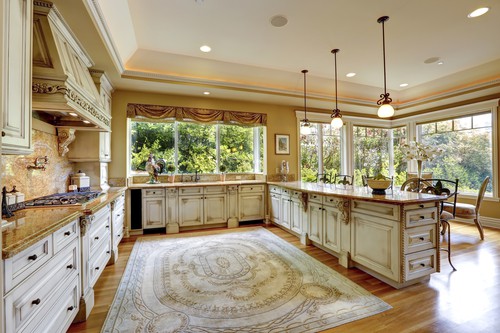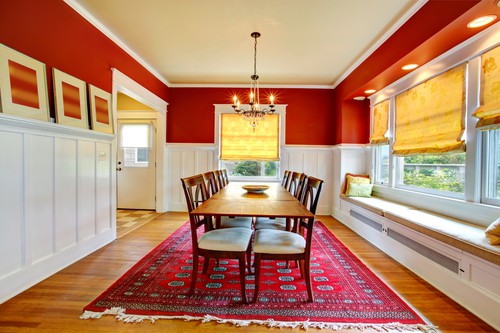There is no doubt that a rug can dramatically change the look of a room and infuse warmth, style, or sophistication (and, of course, a combination of those three). But, to get all that you need the right rug. But, how can you be sure you are buying the perfect rug for your space and needs? To help you out, we’ve consulted experts in the field and put together this guide with the basics you need to know so you can decorate your home with rugs that will tick all your boxes.
1. Consider the rug before the rest
Most of the times, picking a rug for a room is an afterthought. And, although a rug is one of the best ways to complete the look of a space, it’s often added incorrectly. This can bring the exact opposite results and make the room look tasteless or as if it’s lacking that special element necessary to increase the wow factor of the home. The most common mistakes made have to do with the principles of proportion, as well as balance with texture and color (we’ll talk some more on that later on). This is why it’s always best to think of what rug to place in which room and then think of the rest of the décor in that space.
So, regardless of the style you choose, always select the rug first and then build the scheme (set the colors and atmosphere) from the floor up. Now, if you have already furnished the room, focus on a piece of artwork you love or colors that blend in with your furnishings and select a rug with that colors.
2. Scale
The rug has to fit in with the rest of the décor. Therefore, it needs to be scaled appropriately. For example, if you place a small rug in front of a rather large sofa, the rug will disappear and look poor. Experts say that it’s always best to consider a rug as a start point for every room we want to place one and be generous.
3. Placement of the Rug
When it comes to the way you can place the rug so that it complements the room’s décor, opinions vary. Some interior designers suggest we place all the furniture on the rug while others insist that a rug should not define a furniture collection. Well, you can try and see what works best for you!
Another great way to use rugs is to define different areas in the same room. For instance, if you have a large open-plan living space, a rug can help divide the area into zones and, say, differentiate the living room from the kitchen or other dining areas. Specialists say that every space needs to have its own large rug, in this case.
4. Size
There are two dominating options for selecting the correct rug size for a living room. You can either place the sofas around the rug, leaving the coffee table only on top of the rug (traditional method) or go with the contemporary method mentioned above and have all your furniture on top of the rug. In general, a rug the same length and width as a 3-seater sofa is usually ideal, unless you are planning to put the rug under a dining table. In this case, you’ll need a much larger rug, ideally the length and width of a 6-seater or an 8-seater sofa. This is because the chairs take up lots of space and the rug needs to be large enough to allow people to dine and still have their seats on the rug. No, don’t think that a rug that large is too much. They may look enormous when they are hanging in a showroom, but they will most likely seem smaller on your floors. And, for those unsure of the right rug size, you can map out the ideal size with newspaper. Then, you’ll know if the rug you are considering is too small or just perfect for that space.
Now, for dining rooms, the same principle applies as before. The rug has to be large enough to accommodate the chairs when people pull them out to sit down and have dinner. It’s important the legs don’t fall off the rug.
Finally, for the bedroom, you can choose a small rug to place your feet on when you slide out of bed or a larger area rug along the bed. It’s up to you, really!
5. Style
Many homeowners purchase upon impulse. This means that they buy a rug as soon as they see one that appeals to them without considering their lifestyle or their circumstances. According to Prestige-Decorating experts, nine out of ten such buyers end up less happy long term than they ones that choose a rug based on their usage requirements and overall lifestyle. In short, the more educated the choice, the more the rug will not only look better but also last much longer, too. If you choose to invest on a good-quality rug, it will definitely last long enough to pass it on to your children!
Things to Consider:
The amount of foot traffic the rug will receive is critical to the selection of the right rug per space. Also, if you have children that naturally cause a lot of spilling and staining or pets that are not yet well trained, you need a more practical option. Finally, the amount of light entering a room, as well as whether you want the rug to finish off the space or define it should also be taken into consideration.
Depending on what you need and like, you can have a timeless classic, such as an Oriental or Persian rug, or opt for more contemporary styles, such as rugs made from natural materials (i.e. jute, sisal, and hemp). Patterned rugs are also a trend on the rise because they add a more powerful note to a space and are usually placed within a furniture setting to elevate its effect and revamp the space instantly.
6. Color
It’s very easy to fall in pits when using colorful rugs to add to a scheme. The most important thing is balance. The rug has to balance against the other elements in the room (i.e. paints, furniture, and fabrics). Also note that rugs with natural dyes constructed using traditional weaving techniques have an appealing old-age character.
But, what if you are renting a place, hence projects such as painting walls and having the exact furniture a space would require to look great is not an option? In this case, go for bright colors and place rugs in the relatively “bare” areas (without too much furniture).
Final Tips:
1. Underlay is a great addition to a rug that helps provide insulation and absorb sound. Also, if your floor has any kind of unevenness, underlay can allow you to rectify it.
2. Always test the quality of the underlay you are about to purchase. To do that, you can simply stand on it (shoes on). If your heels can feel the floor beneath, then you are looking a low-quality underlay.
3. Always follow manufacturer’s instructions per care and cleaning. There are rugs that can be hand-cleaned at home and others that require professional care to maintain their excellent looks. If you are unsure, check with the rug dealer. Besides everything else, proper care is paramount to be able to enjoy your investment for a long time.







